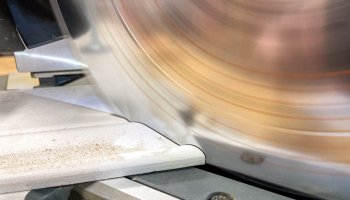
If you buy something through our links, ToolGuyd might earn an affiliate commission.
I finally ordered a benchtop milling machine that I plan to convert to a CNC mill. If you could peek inside my mind, you would be completely shocked by this decision.
In 2010, I wrote a post about how it had become easier to build a DIY CNC machine. At the time, I had researched the idea a couple of times, and there were two paths I could take.
Back then, hobbyists could undertake huge projects to convert common benchtop mills for CNC control, or they could build their own CNC routers using off-the-shelf parts.
Several companies, such as CNC Router Parts – now called AVID CNC and known for their bolt-together CNC routers – sold components that made DIY CNC builds seem easy.
Every time I looked into the hobbyist CNC world, I arrived at the same conclusion, that conversions were hard, routers were easy. This idea stuck with me.
Since then, my plan has been to buy a larger benchtop milling machine for manual use. After doing much research over the years, the relatively new Precision Matthews model PM-728VT benchtop mill remained my top choice.
My other plan has been to save up for an Avid benchtop Pro CNC.
I have been keeping up with turnkey developments, but haven’t found any appealing alternatives. I bought smaller tools, and while they produce some parts for me, they’re not very close to what I’m looking for.
Yes, you do a lot with belt-driven CNC routers and miniature mills that zip around with 1/8″ end mills, but there’s a limit to their functionality when talking about cutting metal.
Some new designs seem promising, such as the Langmuir MR-1, which is described as “an affordable CNC gantry mill for machining metal.” With the Langmuir MR-1, the bed is filled with concrete during user assembly for added rigidity. It’s indeed a unique design, but I’m not sure I’d want to be an early adopter.
Conversions still seemed messy.
While not as ideal as a full-fledged CNC capable of quickly turning aluminum billet into functional parts, a manual mill would help with at least some parts I want to make. Some expansion of what I could build myself is better than nothing, right?
It’s not like any machinery is getting more affordable.
But could I justify the space and expense when the Avid Benchtop Pro CNC router (or something like it) still remains a future goal if/when finances ever permit it? That question had me hesitant to buy anything.
When researching benchtop mills and leaning towards the PM-728VT for the umpteenth time, I saw a post on CNC conversion, and the idea started to take hold.
I went down that rabbit hole a bit, and in doing so I realized how little I knew about the control side of larger CNC machines.
In thinking about it, one of the reasons I never got too close to buying an Avid, aside from its high price, is because its controller is designed specifically for Mach 4 software. Mach 3 was hugely popular, but I’ve heard enough bad things about Mach 4 to want to avoid it.
I didn’t know the first thing about building or even selecting a different controller to use with Avid’s hardware, or any brand’s CNC framing or linear motion kits.
Over the years, I thought that you connect a driver board, such as the 4-axis Gecko G540, some stepper motors, and… run some control software? I assumed this was 90% of what I needed to know about the electronics and control aspect, and that the mechanics were the hard part.
Pictures of Avid’s control enclosure looks more complicated than that.
The idea of a manual to CNC mill conversion was never an option, and at one point over the years I gave up on the idea of building a gantry-style router myself.
There are plenty of kit and read-to-go solutions today, but nothing seemed perfectly suited.
So, I kept waiting, maybe some day I can budget the money and space for an Avid or Tormach, something new and suitable would come along, or another solution would present itself.
And then came the light bulb moment recently.
I convinced myself that converting a benchtop mill for CNC control, and designing and building a controller to operate it with, would be a good idea. At the least, it sounds fun. Plus, if I change my mind, the practically plug-and-play components are universal and could be used in future projects.
Details about the Precision Matthews PM-728VT specifically helped to fuel my decision.
If I changed my mind or it didn’t work out perfectly, most of the same controller parts could be used for a future Avid CNC build, or a CNC-converted lathe.
The PM-728VT weighs around 370 pounds, and offers a sizable increase in stoutness and rigidity compared to my existing micro-sized equipment.
On a scale from 1 to 10 in the manual machining world, this might be a 2.5 in terms of size and rigidity, only ahead of micro and mini mills. In no uncertain terms, it’s a small mill.
I saved up the budget for a bigger machine, but this one seems well-suited for my current and foreseeable needs.
Precision Matthews offers some good-to-have accessories, such as DRO options and a power feed. I intended to buy those at first, when seeing the 728VT as a manual mill upgrade, but was reminded that they offer a ballscrew upgrade kit specifically for CNC conversion.
The company advertises the ballscrew kit as being easily installed with no modifications necessary. Its installation or use also doesn’t affect the milling machine’s 5-year warranty.
Precision Matthews also offers a plug-in spindle control board, although I’ve read mixed reviews about it. That’s something I can figure out with more research.
Third party conversion kits are available for many other benchtop mills from Precision Matthews and other brands, but they tend to require modifications. That’s where mill conversions get messy and require much more attention that I ever wanted to give them.
It seems that maybe the mill was designed at least partially with CNC conversion in mind, and this largely factored into my decision.
All of a sudden, this looks like an easy CNC conversion project, at least mechanically speaking.
The spindle is designed and spec’ed for manual use, but I’m not worrying about that now.
On the controller side of things, yikes! I’m a bit in over my head, but sorted through enough to see where decisions will need to be made.
Do I go with stepper motors, or servos? What controller package? Software? Homing sensors? Do I need limit sensors?
There are now all-in-one controller options like the Masso G3, which works without needing a separate computer, more sophisticated but still affordable solutions like the Centroid Acorn control board, and traditional software such as Mach 3 (or 4) that work with different control boards. There are also Arduino-powered CNC controllers, Ethernet Smooth Stepper boards, and lots more to look into.

So far, I think I’m going with the Centroid Acorn board, which comes with free software and an affordably priced “Pro” upgrade option.
The Acorn is described a “do-it-yourself 4 axis CNC control board for use with mills, lathes, routers, plasma, and a wide variety of machine tools and special applications.”
My goal here is yes, to convert a manual mill for CNC, but also learn all of the little things that I need to know if I ever want to upgrade to something different or bigger.
I have the ominous feeling, however, that this is not going to be an inexpensive venture. The bright side is that, when all is said and done, I’ll either have a CNC-controlled benchtop mill, or a manual mill and bunch of CNC components I can still use towards other automated project needs.
This is going to be quite the adventure.






